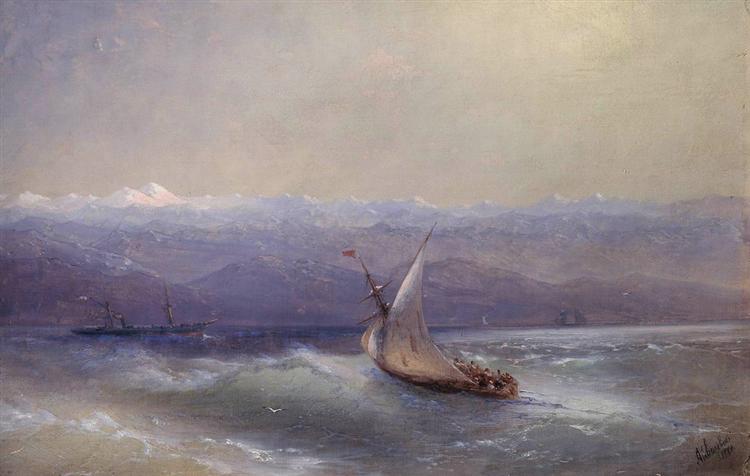Description
Ivan Aivazovsky, one of the greats masters From Russian romanticism, it offers us in his work * Mar at the bottom of the mountains * of 1880, a majestic representation of the marine landscape that melts with unusual harmony elements of the sea and the mountain. He painting, True to its characteristic style, reveals Aivazovsky's ability to capture the transience and vastness of nature, placing the viewer in the center of a sublime and evocative scenario.
The composition of the work presents a restless sea in the foreground, whose waves break with force and dynamism on the coast, creating a feeling of perpetual movement. The sea, represented with a deep -green palette, reflects the artist's mastery by using color to transmit the richness and intensity of the water in constant agitation. The horizon line, far from being a static limit, becomes a soft and ethereal transition that takes us to the mountains in the background.
These mountains, wrapped in a mist that blur their contours, create an atmosphere of mystery and serenity contrasting with the energy of the sea. The combination of terrestrial and aquatic elements is a distinctive feature of Aivazovsky, and in * sea at the bottom of the mountains * it displays it with a skill that almost seems supernatural. The mountains, with their tones of pale and gray blue, grant depth and perspective, extending towards the horizon as a kind of bastion against the sky.
Another notable aspect of the composition is the way in which the sky unfolds in a game of lights and shadows, with clouds that seem loaded with a storm while others reflect the sunlight that struggles for making its way. This color and light management is emblematic of Aivazovsky's work, whose mastery of chiaroscuro allows you to recreate the fluctuating atmosphere of marine landscapes.
In this painting there are no human characters, a decision that is probably not accidental, since Aivazovsky usually plays man in smallness in the face of the immensity of nature. His absence, therefore, does nothing but highlight the magnificence of the natural environment and the insignificance of the human being before the original forces of the world.
It is important to highlight that, although * Mar at the bottom of the mountains * is not one of the best known works of Aivazovsky, masterfully encapsulates the themes and techniques that marked his career. Ivan Aivazovsky, born in Feodosia in 1817, was formed in the Imperial Academy of the Arts of St. Petersburg and developed a deep interest in the sea, which became the central theme of many of his works.
Much of its success lies in the ability to breathe life to its maritime landscapes, making turbulent waters, torments and rock coasts almost palpable for the spectator. In paintings As *the ninth wave *or *the storm *, we see the same passion and technical skill as in *sea at the bottom of the mountains *, where nature is shown as much as a refuge of sublime beauty as in its most indomitable facet and Powerful
In conclusion, * Mar at the bottom of the mountains * is a painting that perfectly encapsulates Ivan Aivazovsky's skill and its deep connection with the sea and nature. Through an outstanding management of color, light and composition, the artist offers us a scene that not only delights the view, but also invites us to reflect on the immensity and mystery of the natural world.
KUADROS ©, a famous paint on your wall.
Hand-made oil painting reproductions, with the quality of professional artists and the distinctive seal of KUADROS ©.
Art reproduction service with satisfaction guarantee. If you are not completely satisfied with the replica of your painting, we refund your money 100%.

